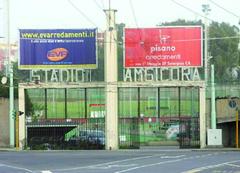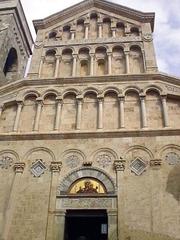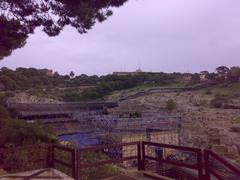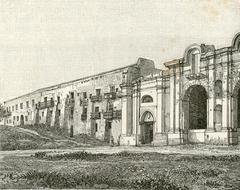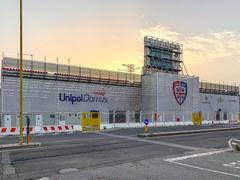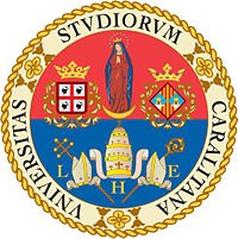Museo Civico D’Arte Siamese Stefano Cardu: Visiting Hours, Tickets, and Complete Guide to Cagliari’s Historic Asian Art Museum
Date: 04/07/2025
Introduction
The Museo Civico D’Arte Siamese Stefano Cardu, located in Cagliari, Sardinia, is one of Europe’s premier destinations for Southeast Asian art enthusiasts. Founded upon the extraordinary collection of Stefano Cardu—a Sardinian entrepreneur and architect deeply connected to the royal court of Siam (now Thailand)—the museum contains rare Buddhist sculptures, ceremonial arms, textiles, manuscripts, and decorative arts. This guide provides an in-depth look at the museum’s history, significance, collection highlights, and practical information to help you plan your visit.
Table of Contents
- Introduction
- Historical Background and Founder
- The Collection: Highlights and Scope
- Cultural Significance
- Practical Visitor Information
- Special Events and Digital Innovation
- Frequently Asked Questions (FAQ)
- References
Historical Background and Founder
Stefano Cardu: Life and Connection to Siam
Stefano Cardu (1849–1933), born in Cagliari, became a prominent figure in 19th-century Siam, contributing to key architectural and infrastructural projects in Bangkok. Through decades of working closely with Siamese royalty and nobility, Cardu was able to amass a significant collection of Southeast Asian artifacts, reflecting both his personal passion and the wider European fascination with Asian cultures of the era (Academia.edu).
The Genesis and Donation of the Collection
Cardu’s collection grew through direct acquisitions from artisans, local markets, and gifts from elite circles in Siam. In 1914, he offered this exceptional trove to his hometown of Cagliari, intending to foster an appreciation of Asian civilizations among Sardinians. After negotiations with city authorities, the collection officially became municipal property in 1923 (Monumenti Aperti; Academia.edu).
Early Exhibitions and Social Impact
The collection’s first public display occurred in 1918 at Palazzo Civico. Cardu himself curated the exhibition and authored its catalogue, dedicating proceeds to First World War orphans. This event marked a pivotal moment, introducing Cagliari’s public to previously unseen Southeast Asian art (Monumenti Aperti).
Museum’s Evolution and Current Location
After several relocations, the Museo Cardu found a permanent home in the Cittadella dei Musei, the main museum complex in central Cagliari. The museum’s galleries are designed to highlight the diversity and richness of the collection with detailed interpretive materials (Musei Civici Cagliari).
The Collection: Highlights and Scope
With over 1,200 artifacts—mainly from Siam but also from China, Japan, India, and Burma—the museum offers a comprehensive view of Southeast Asian material culture from the 14th to 19th centuries. Key highlights include:
- Buddhist Sculptures: Bronze, ivory, and wood representations of the Buddha, bodhisattvas, and mythological figures.
- Ceremonial Weapons: Ornate swords and daggers with silver and niello inlay, reflecting both Siamese and Malay martial traditions.
- Decorative Arts: Silverwork, lacquerware, porcelain, and niello objects.
- Manuscripts: Illuminated Buddhist texts, palm leaf manuscripts, and folding books with elaborate calligraphy.
- Textiles and Jewelry: Handwoven silks, gold and silver adornments, and ceremonial dress.
- Painting: Episodes from the Ramakien (the Thai national epic) and scenes of court and daily life.
- Burmese Art: The Canese Fund for Burma, added in 2011, features Burmese sculptures, ceremonial fans, and tattoo tools (livetheworld.com).
The museum’s thematic and chronological displays provide insight into religious, social, and political life in historical Southeast Asia.
Cultural Significance
Local and Global Impact
The Museo Cardu is Sardinia’s “window to the East,” fostering intercultural dialogue and serving as a vital research resource cited in international scholarship on Southeast Asian art and history (Journal of the Siam Society, 2020). Its presence in Cagliari enriches the city’s cultural identity and attracts scholars, students, and tourists alike.
Contemporary Perspectives
Modern exhibitions at the museum encourage critical reflection on orientalism and colonial-era collecting practices, offering visitors a nuanced understanding of cultural exchange, representation, and heritage stewardship (Musei Civici Cagliari).
Practical Visitor Information
Location, Accessibility, and Directions
Address: Piazza Arsenale 1, 09124 Cagliari, Italy (Cittadella dei Musei, Castello district)
The museum is centrally located and easily accessed by public transport or car. Parking is available nearby, and local bus routes connect to other city attractions (marionigro.it).
Accessibility:
Fully wheelchair accessible, with ramps, elevators, and accessible restrooms. Staff are available for assistance (marionigro.it).
Visiting Hours & Ticket Prices
- Hours: Tuesday to Sunday, 9:00 AM – 7:00 PM (may close for lunch; verify with official website). Closed Mondays and select public holidays.
- Tickets:
- General admission: €5–€8 (variation reflects periodic updates and special exhibitions)
- Reduced: €1–€4 (students, seniors, groups)
- Free: Children under 12, residents over 65, and Cagliari residents
- Tickets available on-site or reserved by email: [email protected] (livetheworld.com)
Guided Tours and Facilities
- Guided Tours: Available by prior reservation; tours in English and Italian cover collection highlights and history.
- Workshops: Educational activities for families and school groups can be arranged (sistemamuseale.museicivicicagliari.it).
- Visitor Services: Accessible restrooms, a climate-controlled environment, orientation by staff, and a serene atmosphere.
- Nearby Amenities: The museum complex includes a café and other museums such as the National Archaeological Museum and Pinacoteca Nazionale.
Travel Tips and Nearby Attractions
- Best Times: Weekday mornings or late afternoons to avoid crowds.
- Combined Visits: Explore other museums in the Cittadella dei Musei for a richer cultural experience.
- Photography: Policies may vary—ask staff on arrival.
- Language: Most labels are in Italian; English tours available with advance booking.
Nearby attractions include the Cagliari Cathedral, Bastione di Saint Remy, and the historic Castello district.
Special Events and Digital Innovation
The museum regularly organizes special exhibitions, workshops, and cultural events. Digital resources such as virtual tours and an online catalogue ensure broader access and engagement. For current programs and digital offerings, check the official website (Musei Civici Cagliari).
Frequently Asked Questions (FAQ)
Q: What are the opening hours?
A: Tuesday–Sunday, 9:00 AM–7:00 PM; closed Mondays (verify before visiting).
Q: How much are tickets?
A: General admission €5–€8; reduced rates available; children under 12 and some residents free.
Q: Is the museum accessible?
A: Yes, with ramps, elevators, and accessible restrooms.
Q: Are guided tours available?
A: Yes, in English and Italian by reservation.
Q: Can I take photographs?
A: Ask staff for current photography policies.
Q: How do I get there?
A: Located at Piazza Arsenale 1, in the Cittadella dei Musei, easily reached by public transport or car.
Summary
The Museo Civico D’Arte Siamese Stefano Cardu is a unique cultural landmark in Cagliari, offering an unparalleled opportunity to explore Southeast Asian art and history. Rooted in Stefano Cardu’s visionary collection, the museum is an essential stop for anyone interested in cross-cultural exchange, Asian art, or Sardinia’s broader historical landscape. Its well-curated exhibitions, educational initiatives, and accessible facilities ensure a rewarding visit for individuals, families, and scholars alike.
Stay updated on visiting hours, special events, and digital offerings via the official museum website. Download the Audiala app for audio guides and cultural itineraries, and follow the museum’s social media for news and exclusive content.
References
- Stefano Cardu: An Italian Contractor in Siam at the End of the 19th Century, His Life and His Art Collection (Academia.edu)
- 100 Years of the Museo di Arte Siamese Stefano Cardu (Musei Civici Cagliari)
- Museo Civico D’Arte Siamese Stefano Cardu, Monumenti Aperti 2024
- The Siam Society Journal, 2020 (Research on Stefano Cardu and the Museo Civico D’Arte Siamese)
- marionigro.it - Museo d’Arte Siamese Stefano Cardu
- livetheworld.com - Museo d’Arte Siamese Stefano Cardu
- Musei Civici Cagliari - Museo d’Arte Siamese (Official)
